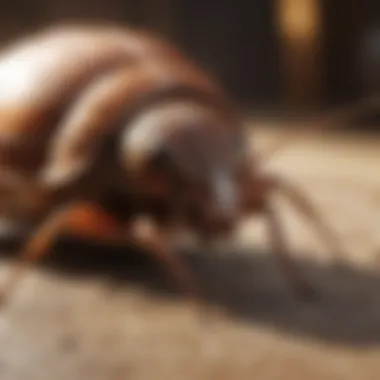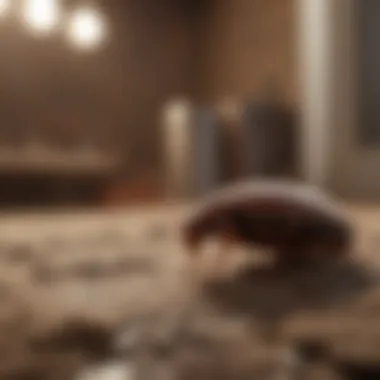Comprehensive Strategies to Eliminate Roaches Effectively


Intro
Roach infestations pose a significant challenge in both residential and commercial settings. Understanding the biology and behavior of these creatures is crucial to effectively tackle their presence. This guide provides insights into various methods for eliminating roaches, emphasizing the importance of sanitation, preventive measures, and different treatment options. By integrating practical knowledge with scientific research, readers will be equipped to combat these pests efficiently.
Fascinating Facts About the Animal
Unique Characteristics
Cockroaches, belonging to the order Blattodea, possess several fascinating characteristics that contribute to their survival. They have flat bodies, allowing them to navigate through tight spaces easily. Their antennae are long and sensitive, enabling them to detect changes in their environment and locate food sources. This unique morphology aids in both their mobility and sensory perception.
Extraordinary Abilities
Cockroaches can survive in extreme conditions, including high levels of radiation. Research indicates that they can withstand radiation doses up to 15 times greater than that lethal to humans. This resilience has made them a subject of scientific study, revealing their unique metabolism and reproductive capabilities. Moreover, cockroaches are able to live without food for a month but can only survive for about a week without water.
Behavior and Habitat
Natural Habitats
Roaches thrive in warm and humid environments. They are commonly found in kitchens and bathrooms, where food and moisture are abundant. Outdoors, they prefer locations under leaf litter, beneath stones, and in decaying wood. Understanding their natural habitats helps in devising effective control strategies.
Social Structures
Cockroaches exhibit social behaviors, gathering in groups, which facilitates communication through chemical signals. This aggregation is essential for mating and resource sharing, making them difficult to eradicate once they infest an area. Their social structures highlight the need for comprehensive management approaches.
Recent Scientific Discoveries
Latest Research Findings
Recent studies have focused on cockroach behavior and their interactions with human environments. Understanding their foraging patterns has led to more effective bait formulations that exploit their feeding behavior, increasing the chances of eradication as they spread the bait among their colonies.
Breakthroughs in Animal Biology
Advancements in genetic research have unveiled insights into their resilience. Scientists are exploring the cockroach’s immune system and its ability to adapt to various toxins, providing valuable information for developing new pesticides that target their vulnerabilities.
Cultural Significance
Animals in Folklore
While often regarded as pests, cockroaches have made their way into various cultural narratives. They represent resilience and adaptability in some folklore. In many societies, roaches are either feared or viewed with an air of curiosity, highlighting their dual perception.
Influence on Art and Literature
Cockroaches have also appeared in art and literature. They symbolize filth or survival, reflecting humanity’s complex relationship with nature's more undesirable creatures. Their presence in creative works serves as a reminder of both humanity's fears and the resilience found in the natural world.
“Understanding the biology and behaviors of roaches provides the foundation for developing effective elimination strategies.”
In summary, gaining an understanding of cockroach biology, habitat preferences, and recent scientific insights is essential for anyone facing an infestation. Combining this knowledge with strategic sanitation and prevention techniques will help in effectively getting rid of roaches.
Understanding Roaches
Understanding roaches is crucial for effective pest control. These insects are not just an annoyance; they can carry diseases and trigger allergies. Knowledge of their biology, behavior, and breeding habits can inform better prevention and elimination strategies. A systematic approach will ensure that treatment is not just a temporary fix but offers long-term solutions.
The Biology of Roaches
Roaches belong to the order Blattodea, which includes over 4,000 species. Among these, about 30 species infest human environments. They are flat, oval-shaped insects typically brown or black, with long antennae. Their bodies are adapted to harsh conditions, making them challenging to eliminate.
These insects are omnivorous scavengers, consuming a wide range of organic materials like food scraps and decaying matter. Their feeding behavior contributes to the spread of bacteria and pathogens, which can potentially lead to various health issues, including food poisoning.


Roaches possess high adaptability. They can survive in low oxygen environments and can live without food for a month, only needing water. This resilience complicates control strategies, highlighting the need to understand their biology when tackling infestations.
Common Species and Their Habitats
Among the most common roach species, the German cockroach, American cockroach, and Oriental cockroach are notable. Each species has specific habitats that prefer:
- German Cockroach: Found often in kitchens and bathrooms. They prefer warm, moist areas close to food sources.
- American Cockroach: Typically inhabits basements and sewers. They are more common in warmer climates.
- Oriental Cockroach: Common in cooler damp areas, such as cellars and drainage systems.
Recognizing these habitats is important in targeting specific species and their hiding spots during control efforts. Proper identification helps tailor strategies that are more likely to succeed.
Lifecycle and Reproduction
Roaches have a unique lifecycle comprising three stages: egg, nymph, and adult. Female roaches lay eggs in protective cases called oothecae, which can contain up to 50 eggs. The lifespan of a roach varies by species, but they can live up to two years in favorable conditions.
Nymphs resemble smaller adults but lack wings and reproductive organs. They undergo several molts before reaching maturity. Each species' reproductive habits and rate contribute significantly to their populations. For example, the German cockroach reproduces rapidly, generating multiple generations each year, which quickly escalates infestations.
Understanding their lifecycle is essential for effective control. Targeting both adults and nymphs during treatment phases maximizes results and reduces future populations. Implementing a combination of sanitation practices and treatment methods allows for a more comprehensive approach in controlling roaches.
Recognizing Infestations
Recognizing infestations is crucial in the process of getting rid of roaches. An early detection can significantly reduce the extent of an infestation. The faster one acknowledges signs of roach presence, the more manageable the problem will be. Roaches are not just unsightly; they can also pose health risks through the transmission of bacteria. Knowing what to look for can help you intervene before the situation escalates.
Signs of Roach Presence
Identifying the signs of roaches is a fundamental step. Common indications include:
- Droppings: Small, oval-shaped feces can often be found in areas where roaches frequent.
- Egg Cases: These dark, leathery capsules contain developing roaches and can be found hidden in corners or crevices.
- Musty Odor: A persistent unpleasant smell can indicate a significant roach population.
- Uneven Surfaces: Look for smudges and stains on surfaces, often a result of grease or dirt from roach bodies.
Observing these signs early allows for quicker action, which can ultimately lead to successful eradication.
Common Hiding Spots
Roaches are experts in finding refuge. They favor warm, dark, and moist areas. Common hiding spots to check include:
- Behind appliances like refrigerators and ovens
- Under sinks and inside cabinets
- In cracks or wall crevices, especially near plumbing or electrical points
- Inside cardboard boxes and clutter
Conducting thorough inspections can expose these crucial hiding places before they become problematic.
Assessing the Severity of Infestation
Understanding the severity of an infestation is necessary for developing an effective control plan. A few factors include:
- Size of the infestation: A small number of roaches often signifies a fledgling problem, while a larger number may indicate a significant invasion.
- Location: Roaches in high-traffic areas are more concerning than those found in seldom-used spaces.
- Droppings and egg cases: The quantity can provide insight into the level of the infestation.
By evaluating these factors, one can decide on appropriate control measures. Early recognition and assessment lead to better outcomes in tackling roach infestations.
Preventative Measures
Preventative measures are crucial when addressing roach infestations. The significance cannot be overstated, as these strategies not only help in reducing the likelihood of roaches entering a space but also assist in managing any existing problems effectively. Implementing these measures creates an environment that is less hospitable to roaches, thereby lowering the risk of infestations.
Sanitation Practices
Sanitation practices play a key role in roach prevention. Maintaining a clean environment deters these pests. Roaches thrive in dirty spaces, where food debris and moisture are prevalent. Here are some vital sanitation steps:
- Regular Cleaning: Sweep and mop floors frequently. Pay attention to hidden areas like under appliances.
- Dish Washing: Wash dishes shortly after use. Avoid leaving dirty dishes in the sink overnight.
- Trash Management: Seal garbage bags tightly and dispose of them regularly. Use bins with tight-fitting lids.
“Cleanliness is one of the most effective deterrents against roaches.”
Implementing these practices can drastically reduce the chances of attracting roaches.


Sealing Entry Points
Sealing entry points is another essential aspect. Roaches can enter homes through small cracks, gaps, or openings. Addressing these areas can prevent infestations. Consider:
- Checking Windows and Doors: Ensure they close tightly. Use weatherstripping if necessary.
- Identifying Cracks: Look for cracks in walls, especially around utilities. Use caulk to seal these openings.
- Inspecting Vents: Make sure that vents are screened and properly sealed.
By focusing on effective sealing methods, you reduce the probability of roaches gaining access to indoor spaces.
Managing Food Storage
Proper food storage cannot be overlooked. It is essential to manage how food is stored to eliminate potential food sources for roaches. Here are steps to consider:
- Use Airtight Containers: Store food in containers that keep bugs out. This includes dry goods like flour and sugar.
- Avoid Leaving Food Out: Do not leave pet food or human food uncovered. Remove leftovers promptly.
- Check Expiration Dates: Regularly clean the pantry. Discard expired items that may attract pests.
Managing food storage practices is a proactive way to eliminate easy access to food sources for roaches, making your environment less inviting.
Natural Remedies
Natural remedies offer a range of alternatives for those seeking to eliminate roaches in a less aggressive manner than chemical solutions. Many individuals and families look for options that are safe for children and pets. These methods can often be effective while presenting a lower risk to human health and the environment. Furthermore, they utilize common household items that may already be in your residence, making these remedies convenient and cost-effective. Understanding the various natural remedies allows for a more holistic approach to pest control that not only targets the immediate problem but also promotes longer-term relief.
Essential Oils as Repellents
Essential oils have gained attention for their pest-repelling properties. Certain oils, such as peppermint, tea tree, and eucalyptus, possess scents that are unpleasant to roaches. Using these oils is quite simple. You can mix a few drops with water in a spray bottle. Apply this mixture to areas where you suspect roach activity, such as baseboards and cabinets. The strong aroma acts as a deterrent, potentially causing roaches to avoid these spaces.
It is important to note that although essential oils may not instantly eradicate an infestation, they can significantly decrease roach presence over time. Opt for high-quality, therapeutic-grade oils for best results, and always test a small area first to avoid damaging surfaces.
Boric Acid Treatment
Boric acid is a well-known insecticide that is effective against roaches. It works by weakening their exoskeleton and adversely affecting their digestive systems once ingested. To use boric acid, sprinkle a light layer in places where roaches frequent, such as under sinks and behind appliances. The powder adhesive coating can cause roaches to carry it back to their nests, affecting the population directly.
When using boric acid, moderation is key. A small amount can go a long way, ensuring it does not create a hazardous situation for pets or children. Consider wearing gloves while applying to minimize direct skin contact. It’s critical to use boric acid with care, focusing on problem areas while maintaining a clean environment to prevent potential risks.
Diatomaceous Earth Usage
Diatomaceous earth (DE) serves as a non-toxic alternative that works on a physical level to control roach populations. Composed of finely crushed diatoms, this powder can cause dehydration in roaches upon contact. To use DE, apply a thin layer in areas where you suspect roach activity.
Avoid excessive application, as a light dusting is sufficient for effectiveness. As roaches traverse areas sprinkled with DE, they collect the powder on their bodies, leading to desiccation. True effectiveness often takes time; thus, patience is vital when utilizing diatomaceous earth as a treatment method.
Diatomaceous earth is safe for both humans and pets as long as it is food grade, making it an appealing option for households looking for manageable pest solutions.
The benefits of integrating these natural remedies into your pest control strategy include a fortified defense against roaches without the harsh chemicals. These approaches foster a tactical framework for immediate and ongoing action against infestations while safeguarding the well-being of your family and pets.
Chemical Solutions
The role of chemical solutions in eliminating roaches is particularly significant. While there are various methods to tackle infestations, the efficacy and speed of chemical treatments often make them a preferred choice for many homeowners and businesses. These solutions offer immediate relief from visible roach populations, which can be crucial in managing a burgeoning infestation. However, it's essential to use these products judiciously, keeping in mind their impact on health, safety, and the environment.
Types of Insecticides
Insecticides used for controlling roaches come in different forms, each designed for specific circumstances and user preferences. Some common types include:
- Aerosols: These are convenient for immediate spot treatments. They can effectively kill roaches on contact. However, caution is needed as they can leave residue, and their effectiveness may vary depending on the concentration.
- Baits: Insecticidal baits contain attractants to lure roaches, combined with slow-acting poison. This allows roaches to carry the poison back to their nests. Baits are often more effective in the long run, as they target the colony, not just individual roaches.
- Granules: These are suitable for outdoor areas, as they can be spread around entry points and perimeters of buildings. They often require moisture to activate but can be very effective in preventing outdoor infestations from entering.
- Dust: Insecticidal dust can reach hidden and void areas where roaches may hide. It is useful for applying into cracks and crevices but must be done carefully to avoid inhalation.
How to Safely Apply Chemicals
Applying insecticides safely is crucial to preventing harm to humans, pets, and the environment. Here are some key guidelines:
- Read the Label: Always read the label of the insecticide carefully. It provides essential information on proper use, dosage, safety precautions, and potential hazards.
- Use Protective Gear: Wear gloves, masks, and goggles when applying chemicals to protect against skin contact and inhalation.
- Ventilation is Key: Ensure adequate ventilation in the area being treated. This helps dissipate fumes and reduces exposure risk.
- Apply According to Instructions: Follow the recommended application method. Over-application can lead to unnecessary risks and may not increase effectiveness.
- Keep Children and Pets Away: Ensure that children and pets are kept away from treated areas until it is safe to return, as indicated on the product label.
Environmental Considerations


Using chemical solutions raises various environmental concerns that warrant careful consideration:
- Potential Toxicity: Many pesticides contain toxic ingredients that can pose risks to non-target organisms, such as beneficial insects and local wildlife.
- Water Safety: Avoid applying chemicals near water sources. Runoff can contaminate water supplies, harming aquatic ecosystems.
- Persistence in Soil: Some insecticides can remain in the soil long after application. This persistence can affect soil health and the organisms residing within.
- Regulatory Compliance: Familiarize yourself with local regulations regarding the use of pesticides. Many regions have specific guidelines to reduce environmental impact.
By understanding both the benefits and risks associated with chemical solutions, users can make informed decisions that balance effective roach control with safety and environmental responsibility.
Using Professional Pest Control Services
Using professional pest control services can be a crucial step in tackling a roach infestation. While DIY methods may offer temporary relief, professionals bring expertise and resources that can effectively address more severe issues. They possess a comprehensive understanding of roach behavior, reproductive cycles, and optimal treatment methods. This understanding allows them to craft a targeted approach that maximizes the chances of successful eradication.
Moreover, these services can help prevent future infestations. Professionals often provide ongoing monitoring and maintenance plans that ensure a roach-free environment. By partnering with a pest control service, you not only address the current problem but also take steps to prevent re-infestation. This prospective viewpoint is essential for long-term peace of mind.
When to Call a Professional
Recognizing the right time to call in experts is key to effective pest management. Here are some indicators:
- Severe Infestation: If you observe multiple roaches daily, both dead and alive, professional help may be necessary.
- Inadequate Results from DIY Methods: If your attempts at pest control do not yield results within a reasonable timeframe, consider contacting professionals.
- Health Concerns: Roaches can carry diseases and allergens. If someone in your home suffers from respiratory problems or allergies, prompt action is advisable.
- Commercial Spaces: Businesses with customers cannot afford delays. Professional pest control ensures compliance and protects your reputation.
What to Expect from a Service
Understanding what a pest control service entails can ease concern and set proper expectations:
- Initial Inspection: Technicians will begin with a thorough assessment of your property to identify the level of infestation and pinpoint entry points.
- Customized Treatment Plan: Based on the inspection, professionals will create a tailored strategy using a combination of chemical and non-chemical treatments.
- Follow-Up Visits: Many companies offer follow-up appointments to monitor progress and make adjustments to treatment if necessary.
- Tips for Homeowners: Expect guidance on sanitation and prevention measures to complement the professional treatment.
“Professional pest control is not merely about killing bugs. It's about creating an environment where pests cannot thrive.”
Evaluating Pest Control Options
When selecting a pest control provider, assess your choices carefully. Here are some factors to consider:
- Reputation: Research reviews online. Websites like Reddit and Facebook often have firsthand accounts from users.
- Licensing and Insurance: Confirm that the service is licensed. Insurance protects against damages caused during treatments.
- Methodology: Ask about the products and techniques used. Ensure they align with your preferences, especially if you have pets or children.
- Cost and Contracts: Compare pricing, and be wary of long-term contracts. Understanding costs upfront is crucial for budgeting.
Engaging professionals can significantly impact your battle against roaches. Choose wisely, maintain clear communication, and prioritize your needs and environmental concerns.
Monitoring and Ongoing Prevention
Monitoring and ongoing prevention are critical components when it comes to managing roach infestations. This aspect ensures that the efforts you put into elimination do not go to waste. Roaches thrive in environments that provide food, water, and shelter. Thus, understanding their presence early and taking proactive measures can significantly reduce the chance of future infestations. By maintaining a routine of monitoring and prevention, you can successfully create an inhospitable environment for these pests.
Setting Traps for Monitoring
Setting traps is an effective way to monitor the presence of roaches in your space. There are various types of traps available, such as glue traps and bait stations. Glue traps help to catch and kill roaches, while also giving you insight into their activity. You can place these traps in strategic locations, mainly near suspected hiding spots or entry points. Check these traps regularly to assess the level of infestation.
- Choose traps that are specifically designed for roaches.
- Position traps in dark, secluded areas where roaches tend to roam.
- Note the number of roaches caught in order to track trends over time.
Implementing a monitoring strategy with traps not only helps in realizing an infestation but also aids in adjusting your approach as needed.
Regular Inspection Schedules
Regular inspections should form a part of your routine maintenance. This practice allows you to identify potential problems before they escalate. A thorough inspection can include checking for visible roach sightings, droppings, egg cases, and any signs of damage to materials like paper or wood.
- Develop a schedule that suits your lifestyle, whether weekly or monthly.
- Focus on high-risk areas such as kitchens, bathrooms, and basements.
- Use a checklist to ensure thoroughness during inspections.
Consistency in inspections helps ensure that any roach presence is either mitigated promptly or effectively monitored. This proactive approach also reinforces a general awareness of hygiene and cleanliness within the premises.
Long-term Prevention Strategies
Preventing future roach infestations requires commitment and a multifaceted approach. Key strategies should focus on maintaining cleanliness, sealing entry points, and controlling moisture levels.
Effective prevention strategies include:
- Routine deep cleaning: Regularly clean areas where food is prepared and consumed. Pay attention to crumbs and spills.
- Sealing cracks and crevices: Inspect the premises for any gaps that may serve as entry points for roaches. Using caulk or other sealants can eliminate these vulnerabilities.
- Managing humidity: Roaches are attracted to moisture. Ensure proper ventilation and repair any leaks in plumbing.
Through consistent effort and attention to these areas, you can create an environment less conducive to roaches. Monitoring and ongoing prevention are essential for long-term peace of mind.
Effective monitoring and prevention can reduce the risk of infestation. Establish routine checks and apply preventive measures to maintain a roach-free environment.







